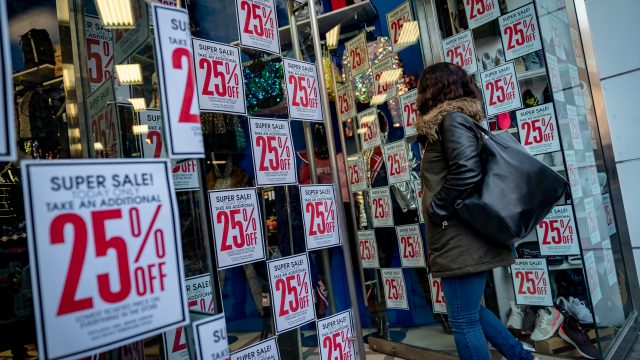Isn’t This a $20 Million to $50 Million Tax Hike?

A customer enters a shop at Fulton Mall in New York on Black Friday, Nov. 23, 2018. As the official start of the holiday shopping season begins, retailers and analysts say Black Friday 2018 appears to be off to a strong start. (David Dee Delgado/The New York Times)
“North Dakota collected $750,000 more in new online sales taxes since late June, when the Supreme Court ruled states could require online retailers to collect and remit their sales taxes,” my colleague Helmut Schmidt reported over the holiday break.
His article casts this number in a positive light. Certainly the people quotes are happy about it.
“It does level the playing field and that’s all we’ve been seeking for the last 10 or 15 years that it took to get this finally in place on a national level,” Mike Rud, president of the North Dakota Retailers Association, is quoted as saying.
“It’s about time getting it done. This has been going on a long time. Obviously, I think they should have to work under the same situation that we do. …. North Dakota to their credit has done a pretty good job of it,” Greg Danz, owner of Zandbroz Variety in downtown Fargo, told Schmidt.
[mks_pullquote align=”left” width=”300″ size=”24″ bg_color=”#ffffff” txt_color=”#000000″]We are talking about a shift in tax policy which could result in (mostly) North Dakotans paying as much as $100 million in additional taxes in a biennium. [/mks_pullquote]
The amount of additional taxes paid so far is not a particularly large number, but the new sales tax regime has only been in place for a few months. Numbers are going to grow as more online sales are taxed, and more online retailers comply.
Schmidt quotes Tax Commissioner Ryan Rauschenberger as saying the state could realize anywhere from $20 million to $50 million in additional tax revenues in a given year.
That’s more money for the state, sure, but the money isn’t appearing out of thin air.
It’s coming from our pockets.
It surprises me that more people aren’t looking at this policy shift that way.
We are talking about a shift in tax policy which could result in (mostly) North Dakotans paying as much as $100 million in additional taxes in a biennium.
To put that number into perspective, the last time North Dakota’s politicians cut the income tax rates – during the 2015 session under former Governor Jack Dalrymple – they were crowing about the estimated $108 million in tax relief it would provide North Dakotans. This policy change was touted as real, meaningful reform which would have a positive impact on the state’s economy.
So what, then, are we to make of a potential $100 million tax increase? If a $100 million tax cut is good for the economy, what is a $100 million tax hike?
I’m not saying there aren’t positives, particularly for brick-and-mortar retailers, in collecting the sales tax from online transactions. Only that there are economic negatives too which few seem willing to talk about.
Not to mention this new precedent, set by the Supreme Court when it overturned Quill vs. North Dakota to allow this collection of taxes, which now allows state governments to implement their policies on business entities which have no physical presence in their borders.
If you don’t think states like, say, California aren’t going to test the boundaries of that new policy frontier in areas like environmental regulation, think again.




